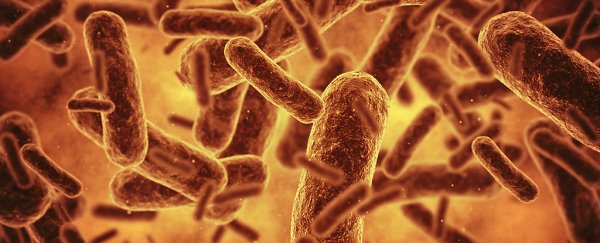Scientists have reworked the DNA of Escherichia coli to help us understand apparent redundancies in its genetic code. At four million base pairs in size, they now have the results of the most ambitious attempt at a completely synthetic form of life.
For all its immense variation, life on Earth all shares a common language in its DNA. A handful of chemical letters are used to create dozens of three-letter 'words', each of which can be translated into the dialect of proteins that conduct biology's heavy work.
The four nucleic acid letters of adenine, cytosine, guanine, and thymine – or A, C, G and T – can be strung into 64 combinations of three-letter words called codons.
Biology makes use of 61 of those codons to represent just 20 amino acids. The other three are a punctuation mark designating the end point to a single gene's template.
Like a DNA thesaurus, our genes use one of several words to refer to the same thing. This makes for a lot of redundancy, and for good reason, too. Accidental changes that turn a codon into one of its synonyms aren't anywhere near as bad when they all translate into the same product anyway.
But just how much wiggle room do we really need here? Sure, nature can be brutal, but under controlled laboratory conditions, could we have room to edit this waffle down to something a little more concise?
To find out, the research team at Cambridge University took a look at the entire genetic code of a strain of E. coli and highlighted every time one of three different codons appeared. Two of those would translate into the amino acid serine, while the third was a stop codon.
These triplets were all replaced with one of the other four codons for serine, or one of the other two stop codons.
On paper, those 18,000 edits are about as 'simple' as doing a word-swap in a digital copy of War and Peace. The real challenge was stitching together a chemical copy of the rewritten genome and exchanging it for the original inside living organisms.
The team approached this task slowly and steadily, swapping the genome out of the bacteria in stages. As each synthetic piece replaced the original code, the researchers watched to see whether the bacteria would function or perish.
"It was completely unclear whether it was possible to make a genome this large and whether it was possible to change it so much," biologist Jason Chin told Ian Sample from The Guardian.
The edited variation, simply referred to as Syn61, isn't quite a dead ringer for its ancestor. The cells are a touch longer, and they reproduce 1.6 times slower.
But the edited E. coli seems healthy, and produces the same range and quantity of proteins as the non-edited versions.
This is all good news for researchers who are keen to push the limits on editing bacterial genome in order to use the organisms in the production of a range of synthetic materials in the future.
Recent advances in synthetic biology have seen the introduction of new bases to the traditional four, suggesting a future revolution in life that might be unlike anything seen on Earth before.
The invention of a completely novel life form won't take place as a single genesis, but in landmark steps like this one.
In 2010, researchers from the J. Craig Venter Institute in Maryland succeeded in creating the very first synthetic genome by reconstructing all 1.1 million base pairs of DNA inside Mycoplasma mycoides and transporting it into a closely related species.
Since then, further research has delved into discovering which of these genes are essential and which can be dropped.
Knowing which features of Life 1.0 we can lose and which are vital is important if we're to succeed in blurring the boundaries between technology and biology. Life 2.0, here we come.
This research was published in Nature.
